
Apollo 13 suffered a catastrophic explosion en route to the Moon but has since become known as “a successful failure” because the three-man crew was able to safely return to Earth thanks to the round-the-clock heroic efforts of the entire NASA team to devise a solution to save the trio. NASA’s third planned manned lunar landing mission launched 50 years ago on April 11, 1970. After the successful lunar landings of the prior two missions, Apollo 13 was considered routine by many of the populace and the media, however, that would change after the explosion. The resulting race to save the crew riveted the world.
In celebration of the mission’s anniversary, NASA has released a new documentary entitled Apollo 13: Home Safe. The 30-minute video goes inside the spacecraft and mission control on the ground via archived footage and interviews with the two surviving Apollo 13 astronauts James (Jim) Lovell Jr. and Fred Haise Jr., as well as Flight Directors Gene Kranz and Glynn Lunney, and engineer Hank Rotter.

Apollo 13 was the seventh crewed mission in the Apollo space program. The crew was comprised of Commander Lovell, Command Module Pilot John Swigert Jr. and Lunar Module Pilot Haise.
Swigert was a late replacement for Ken Mattingly, who was grounded after exposure to rubella mere days before the launch.
Their Saturn V rocket launched at 2:13 p.m. EST on April 11, 1970, from Launch Pad 39A at NASA’s Kennedy Space Center in Florida. The command module was named Odyssey, and the lunar module was named Aquarius. The lunar module served as a lifeboat for the crew after the service module’s explosion during the third day left Odyssey nearly powerless, with what little battery power remained needing to be conserved for reentry days later.

“Our goal 50 years ago was to save our valiant crew after sending them around the Moon and return them safely to Earth,” said NASA Administrator Jim Bridenstine.
“Our goal now is to return to the Moon to stay, in a sustainable way. We are working hard to ensure that we don’t need to respond to this kind of emergency in Artemis, but to be ready to respond to any problems we don’t anticipate.”
“As we mark the 50th anniversary of our Apollo 13 mission, we’re sharing memories, recognizing the triumph of the mission control team and the astronauts, and looking at how those lessons learned can be applied to our lunar Artemis program. Apollo 13 has become known as ‘a successful failure’ that saw a safe return of the crew in spite of a catastrophic explosion,” stated NASA.
Watch the NASA documentary Apollo 13: Home Safe for free below (or on YouTube) to find out how NASA turned tragedy into one of the most storied successes of the agency’s 61-year history.



